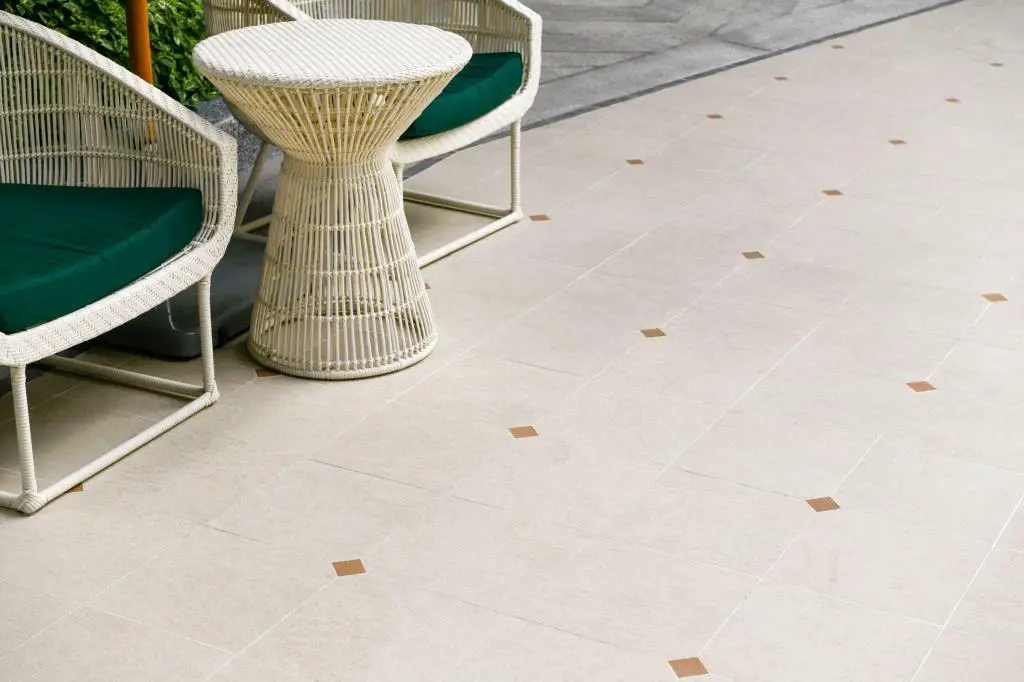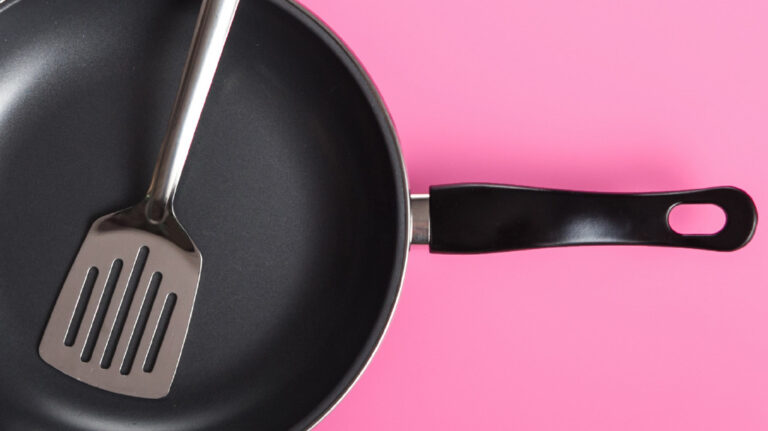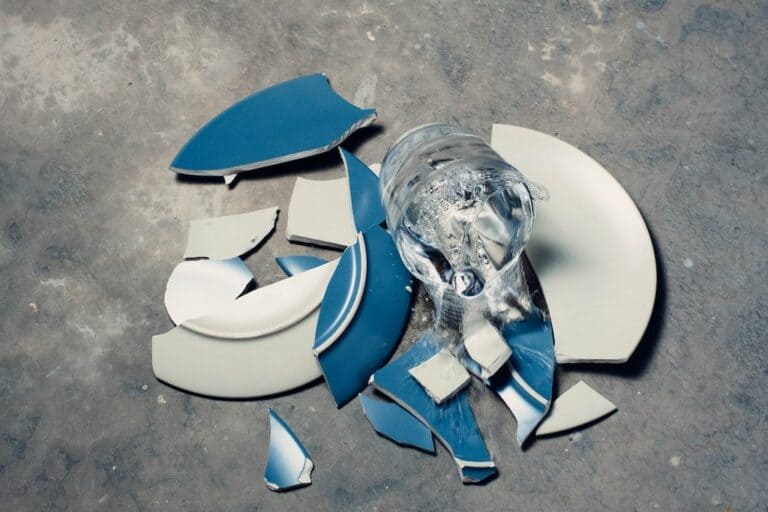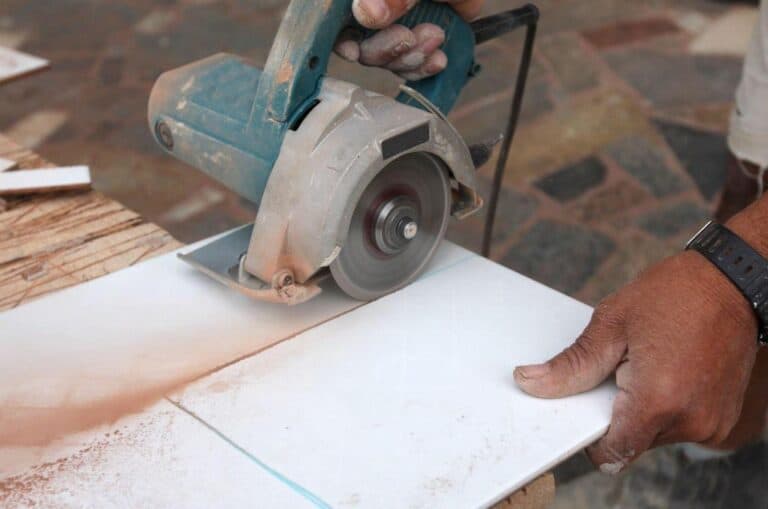Can I Use Ceramic Tiles Outside? (Is It Suitable and Safe for Outdoors)

Are you thinking about using ceramic tiles to make your outdoor space look better and more useful? Can you use ceramic tiles outside?
Ceramic tiles offer a great way to update the look of any outdoor area, but it’s important that they are designed for exterior use. That’s because certain types of tiles may not withstand exposure to rain or sunshine and could become damaged over time.
Before you decide to use ceramic tiles outside, you need to find out if they will work in your climate and weather. Additionally, make sure that the surface is properly prepared so that the tile won’t move or crack due to weather changes or other elements.
In this blog post, we’ll talk about how to decide if it’s safe and appropriate to use ceramic tiles outside, as well as how to get the most out of them and make them last longer.
Whether you’re looking to update your patio, walkway, or pool deck, this post will provide the information you need to make an informed decision about using ceramic tiles outside.
Ceramic Tiles and Their Popularity as a Flooring Material
Ceramic tiles are a popular choice for flooring because they are durable, can be used in many different ways, and don’t need much upkeep.
They are made from clay, sand, and other natural materials, which are fired at high temperatures to create a hard, dense surface.
Ceramic tiles don’t get damaged easily by water, stains, or wear and tear, which makes them a good choice for flooring both indoors and outdoors.
Not only are they practical, but they also come in many different colors, patterns, and styles, so they can be used in many different ways. They can be used to create a traditional, classic look or a more modern, contemporary aesthetic.
Ceramic tiles are often found in kitchens, bathrooms, and entryways, among other places. They are also often used for outdoor patios, walkways, and pool decks because they can stand up to the weather and a lot of foot traffic.
Can Ceramic Tiles Be Used Outside?
Ceramic tiles are often used as flooring inside, but can they also be used outside? The answer is yes. Ceramic tiles can be a nice addition to your outdoor space because they last a long time and come in many different styles.
The tile’s material is one of the most important things to think about when deciding if it can be used outside. Porcelain tiles are often considered a better choice for outdoor use due to their high density and resistance to moisture, but this is not always the case. While porcelain tiles can be a good choice for outdoor use, there are other factors to consider as well.
Ceramic tiles are also a common choice for outdoor use, and they can be just as suitable as porcelain tiles in some cases. The key is to choose tiles that are made to be used outside and can stand up to the weather and other conditions where they will be put.
This could include things like how hard and dense the tiles are, how porous they are, how well they can handle water, and how well they can handle extreme weather.
It is also important to think about how the tiles will be used and how much traffic they will get. Tiles that are used on a patio or walkway, for example, may need to be able to withstand heavy foot traffic and may require a harder, denser tile. Tiles used around a pool or in an area exposed to water may need to be more slip-resistant.
Factors to Consider When Choosing Ceramic Tiles for Outdoor
There are certain factors to consider when deciding whether or not ceramic tiles are right for you.
- Hardness and durability of the tiles. Outdoor environments can be subjected to heavy foot traffic, as well as extreme weather conditions such as freezing temperatures and heavy rain. Tiles that are too soft or brittle may not be able to withstand these conditions and may crack or break under the stress. On the other hand, tiles that are too hard may be difficult to cut and install, and may not be as comfortable underfoot.
- The porosity of the tiles is another factor to consider when determining their suitability for outdoor use. Tiles that are highly porous may absorb water and stains easily, making them more prone to damage and difficult to clean. Tiles that are less porous, on the other hand, will be more resistant to moisture and stains, making them a better choice for outdoor use.
- The ability of the tiles to withstand extreme weather conditions is also an important consideration. Outdoor environments can be subjected to a wide range of temperatures and weather conditions, and tiles that are not able to withstand these conditions may become damaged or weakened over time. In particular, tiles that are prone to freezing and thawing may become prone to cracking, which can compromise their structural integrity.
- Lastly, how slippery the tiles are is another important thing to think about when deciding if they can be used outside. Wet tiles can be very slippery and can be dangerous for people walking, especially in areas where there are a lot of people. Tiles with a textured or patterned surface, or those with a high slip resistance rating, may be a safer choice for outdoor use.
- Make sure to choose ceramic tiles that are specifically designed for outdoor use. These tiles are usually thicker and more durable than indoor tiles, and are treated to withstand extreme temperatures and the effects of the weather. They may also have a rough or textured finish to prevent slipping when wet.
- Another important factor to consider is the location of the tiles. If you live in an area with freezing temperatures, it’s important to ensure that the tiles are installed on a surface that is properly insulated and graded to allow for proper drainage. This will help prevent the tiles from cracking due to frost heave.
- When considering ceramic tiles for outdoor installation, look for products labeled as “frost-proof” or “frost-resistant.” These special formulations will not crack due to freezing temperatures, meaning they can withstand the harsh conditions outside your home throughout all four seasons.
- Additionally, glazed ceramic tiles are also recommended since they provide superior protection against moisture damage resulting from rain or snowfall.
The durability and low maintenance of ceramic tiles make them a great option for outdoor applications, but it is important to understand what types of ceramic tiles can be used in exterior settings.
Pros & Cons Using Ceramic Tiles for Outdoor
Pros
Cons
- Durability: Ceramic tiles are known for their durability and ability to withstand heavy foot traffic and extreme weather conditions. They are resistant to water, stains, and wear, making them a practical and long-lasting flooring option for outdoor use.
- Versatility: Ceramic tiles are widely available in a range of colors, patterns, and styles, allowing for a wide range of design options. They can be used to create a traditional, classic look, or a more modern, contemporary aesthetic.
- Low maintenance: Ceramic tiles require minimal maintenance and are easy to clean. They can be swept, mopped, or hosed down to remove dirt and debris, and are resistant to stains, making them a low-maintenance flooring option for outdoor use.
- Eco-friendly: Ceramic tiles are made from natural materials, such as clay and sand, and are fired at high temperatures to create a hard, dense surface. As a result, they are a more environmentally-friendly flooring option compared to other materials, such as synthetic carpets or vinyl.
- Cost: Buying and installing ceramic tiles can be more expensive than buying and installing concrete or wood.
- Fragility: Ceramic tiles can be prone to cracking or breaking if they are subjected to heavy impact or dropped.
- Slipperiness: Wet ceramic tiles can be slippery, particularly if they are smooth or have a high gloss finish. This can pose a hazard to pedestrians, particularly in areas with high foot traffic.
- Installation: Installing ceramic tiles can be a time-consuming and labor-intensive process, and may require the assistance of a professional. It is important to ensure that the tiles are properly installed and sealed to prevent moisture damage and ensure the tiles remain stable and safe.
Tips for Using Ceramic Tiles for Outdoors
Here are some tips for putting ceramic tiles outside that will make them safer and more useful:
- Choose tiles with high slip resistance ratings. Wet tiles can be very slippery, particularly if they are smooth or have a glossy finish. To increase the safety of outdoor ceramic tiles, it is important to choose tiles with a high slip resistance rating. This rating is usually indicated by an “R” value on a scale from “R9” (low slip resistance) to “R13” (high slip resistance). Most people think that tiles with a rating of “R10” or higher have a good level of slip resistance.
- Use tiles with a textured or patterned surface. Textured or patterned tiles are safer for outdoor use because they increase traction. Textured tiles can be created using a variety of techniques, such as sandblasting, acid etching, or breakingembossing, which create a rough, uneven surface on the tile. Tiles with patterned surfaces, such as mosaics, can also increase traction.
- Properly seal the tiles. Sealing ceramic tiles can help to protect them against moisture and stains, which can be particularly important for outdoor use. Sealed tiles are more resistant to water penetration and are easier to clean, making them a better choice for outdoor environments. Applying a high-quality crackingcracking. .In extreme weather, it can insulate tiles and protect them from temperature changes..
- Use grout. Grout is a cement-based material that is used to fill the gaps between tiles and provide a seamless surface. Grout prevents water and debris from getting between outdoor ceramic tiles, which can damage and make them harder to clean. Use outdoor-grade grout and follow the manufacturer’s instructions.
- Protect the tiles from damage. Foot traffic, impact, and extreme weather can damage outdoor ceramic tiles. In high-traffic areas or extreme weather, mats or rugs may be needed to protect tiles. It is also important to avoid using abrasive or corrosive cleaning products on the tiles, as these can damage the surface.
Which Type of Tile Should Not Be Used Outside?
When choosing tiles for outdoor use, it’s important to choose tiles that are made for outdoor use and can stand up to the weather and other conditions of the area. Some tiles may not be strong enough or able to handle the weather well enough to be used outside.
One type of tile that should generally not be used outside is unglazed ceramic tiles. These tiles are not fired at the same high temperatures as glazed ceramic tiles, which means they are more porous and prone to staining and moisture damage. Because they are not as hard or dense, unglazed ceramic tiles may also be more likely to chip or break.
Another type of tile that should generally not be used outside is natural stone tile. Tiles made of natural stone, like marble or granite, are usually more expensive and don’t last as long as ceramic tiles.
They are also more prone to staining and scratching, and may be more difficult to maintain. Also, natural stone tiles may be more likely to break or crack because of the material’s natural differences, which can be made worse by extreme weather.
Finally, it is generally not recommended to use tiles made from porous materials, such as cork or bamboo, outside. These tiles are more prone to moisture damage and may warp or rot when exposed to damp conditions.
They might also be more likely to get dirty and need more cleaning and maintenance to stay in good shape.
Why You Need Sealing Ceramic Tiles for Protection
Sealing ceramic tiles is a process that involves applying a protective coating to the surface of the tiles to help protect them against moisture, stains, and wear.
Sealing ceramic tiles is an important step in the installation process and can help to extend the life of the tiles as well as improve their appearance and performance.
One of the main reasons to seal ceramic tiles is to protect them against moisture. Ceramic tiles are usually resistant to water, but if they are not properly sealed, they can still soak up water.
This can cause damage to the tiles, like stains, discoloration, or warping, which can hurt their strength and appearance. When you seal the tiles, you make a barrier between them and the water. This keeps water from getting under the surface and causing damage.
Another reason to seal ceramic tiles is to protect them against stains. Unsealed tiles are more likely to get stained because they are porous and let spills and other dirt get into the surface. Sealing the tiles creates a barrier that helps prevent stains from setting in and makes the tiles easier to clean.
Sealing ceramic tiles can not only protect them from water and stains, but it can also make them look better. Most sealed tiles are smoother and reflect more light, which can make the floor as a whole look better.
Sealed tiles are also easier to take care of because they need to be cleaned less often and are less likely to get stained.
Conclusion
It is important to carefully consider the specific needs and conditions of the intended outdoor environment when selecting tiles, and to choose tiles that are specifically designed for outdoor use to ensure the best performance and longevity.
Sealing ceramic tiles is an important step in the installation process that can help protect the tiles against moisture, stains, and wear. To get the best performance and results, it is important to use a high-quality sealer that is made for ceramic tiles and to follow the manufacturer’s instructions for how to use it.
In general, ceramic tiles can be a great choice for outdoor spaces such as patios, sidewalks, and pool decks. They are easy to take care of because all you have to do is sweep them regularly and clean them once in a while with a mild detergent.
Ceramic tiles can be a durable and attractive surface for your outdoor space if they are installed and cared for the right way.





